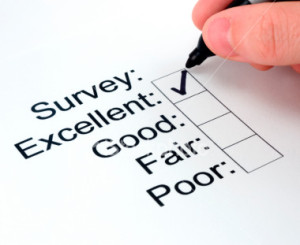We love employee surveys. We hate employee surveys. What is the best way to use the results of an employee survey? What do the  survey results really tell us anyway?
survey results really tell us anyway?
Let’s look at this from the perspective of a couple that wants to improve their health.
Pat and Mike are wanna-be runners. Right now they are couch potatoes. They want to get healthier, and have decided that jogging would be a good exercise to improve personal health. If you were Pat or Mike, what would you do next?
Pat likes data, so she says she wants to know how fast she can jog a mile today. Mike doesn’t really care about data. He just wants to get up and begin taking action as soon as possible.
Pat makes arrangements for them to jog a mile together. She has a stopwatch, has marked out the course so she can measure a mile, and has picked a date for them to jog together next week. Mike agrees to go along with her and time a one-mile run.
Next week arrives and they get together and jog a mile. They keep track of how long it takes them to run a mile. Pat records their time. She also asks some questions about how each of them felt before, during and after the run, and some other questions about healthy life choices, diet, other exercise and work life balance.
Pat just conducted a survey. Much like an employee opinion survey, the survey she took is a snapshot of a specific point in time. Some aspects of it are quantitative and some are subjective.
 Mike doesn’t really care about the measurement. He just wants to get healthier. Over the next couple of months, Pat and Mike continue to jog together, however, other aspects of their approach to a healthy routine differ.
Mike doesn’t really care about the measurement. He just wants to get healthier. Over the next couple of months, Pat and Mike continue to jog together, however, other aspects of their approach to a healthy routine differ.
Pat does some research on how fast it takes other people to run a mile. She learns that the fastest men’s time is 3:43.13 set in 1999 and the fastest women’s time is 4:12.56 set in 1996. She makes notes of these times and puts this data in a graph.
Pat has now created one of those fancy employee survey results graph, perhaps similar to one you have seen at your place of work. Again, similar to ones you may have seen, Pat’s graph is full of numbers. It is all very interesting. Pat likes the graphs and Mike is not really sure how meaningful the data is.
In the meantime, Mike has been doing his daily jogs, he has also made some small changes to his diet, and adjusted some aspects of his daily schedule. For example, he finds it easier to get up on time, no longer stays up late watching infomercials, and finds he is more focused at work. Mike has been gradually feeling better day-by-day. He in convinced that getting up off the couch and taking action was a good idea.
Pat has invested more time in researching things she feels is related to the survey. Such as, what is the best non-meat based protein, since she is considering a vegetarian diet. She isn’t sure yet, but she might want to make a change in her diet. She is also researching different types of stretching exercises since she doesn’t want to waste time doing exercises that are not productive.
Mike has added some non-jogging exercise to his routine. He is stretching, working out with light weights, and, while in the office, he is doing some isometrics. To solve the exercise selection dilemma, Pat is looking at getting a membership to a local gym, convinced that having a defined schedule imposed on her might be good motivation and following the routines developed by an expert would be more beneficial to her.
A few months later Mike suggests they join a local jogging club. He thinks it would make sense to connect with others who share their ambition. Pat agrees. They both find themselves trading war stories with their new friends in the jogging club. At one of the monthly gatherings Pat suggests they all participate in a one-mile test run as a way to measure the jogging engagement of the club. Most members agree.
Pat just conducted the equivalent of another employee survey. She took a snapshot of the jogging club’s one-mile jogging performance. As before, some aspects of it are quantitative and some are subjective. She added in more demographic information, and is able to produce several pages of graphs showing data by gender, by length of time as members in the club, by age, and by shoe brand.
Pat is proud of the graphs she has produced and sets up some meetings for the club to review the results. Much discussion is generated. The club starts to undergo some changes. There are those who spend more time discussing the survey results with Pat, and less time working out and less time jogging. Others follow Mike’s example. They participate in the discussions, however, rather than doing fewer workouts, they ramp up their workouts by adding variety to their routines. They get together in small groups and push each other to meet greater challenges.
A year passes. Pat schedules another one-mile test. Most of the club members plan to participate. Some club members don’t show up, however, they don’t really show up for club meetings, and are not actively working out either. For some reason, they are not engaged with the mission of the jogging club. The results of the most recent survey show overall club performance has improved. However, this survey also shows marked differences from the prior one. Members who are scoring well are scoring better and those scoring poorly are scoring worse.
Because the survey results were disappointing to Pat and others, they met more regularly to dissect the survey detail, they schedule additional time to do research, to view the results from as many different perspectives as possible, and to outline a series of plans and options for the club.
While Mike attends a few of these discussions, he focuses on taking action, and steadily continues the discipline of his exercise routine. A few more club members follow his example. Pat, too, is motivated by the action Mike exhibits.
For example, Pat schedules group-stretching times, with a list of stretches approved by a club stretching committee. Another committee has scheduled detailed group jogging sessions. Mike and other very active club members attend these sessions at first. However, during one of the stretching sessions, Pat and others spent most of the session debating which stretching exercises were actually best. Club members were questioning the recommendations from the stretching committee. After a vote was taken to determine where to start stretching, Pat and others from the stretching committee insisted that everyone stretch in unison. With such a large club, getting everyone to stretch at exactly the same time, in the same way for the same duration proved difficult. However, Pat put a lot of time and energy into this and at the end of the session, most of the attending club members were roughly in unison. At least for the last stretch of the session. Well, given the debates, the lack of consensus and the lengthy dialog, that last stretch was the only stretching exercise the group was able to do. The session ended with the stretching committee deciding to add a stretching session review item to the agenda for its next meeting.
During this stretching session, Mike and those like him who were active, continued to stretch while others debated. Some of the non-stretching members felt this was disrespectful and criticized those stretching during the stretching session, insisting they stop stretching so that the debate could be held uninterrupted by stretching. Mike smiled and continued to stretch.
At the stretching committee’s next meeting, a decision was reached to cancel half the stretching sessions so the stretching committee could have more time to review, analyze and plan improved stretching sessions. Most club members did not mind. Those that stretched on their own, continued to do so. They did not seem to need a committee for this.
At the next general meeting of the club, Pat led a discussion about the time it took to run a mile. She shared that the fasted men’s time was less than four minutes and the fastest women’s time was just over four minutes. Pat had benchmarked the club’s times to this. Overall the club had a time of just over ten minutes. The club’s time varied by demographic group, with some demographic slices just under eight minutes and some well over twelve minutes. There was much nonproductive debate over the impact of shoe brand on the time it took to run a mile. However, that data was present, so Pat and others insisted it deserved attention.
With the club data benchmarked to the one-mile times of world-class runners, Pat shared a new concern. She and others pointed  out how the data now showed how horrible the club was, how poorly it was performing, and how bad things really were. After all, an overall of ten minutes benchmarked to world-class of about four minutes was atrocious. Things could not be worse. Some said there was something wrong with the survey, the right questions were not being asked. Some said there was something wrong with the data, perhaps someone had manipulated the data on purpose to make things look bad. Some said they were not given an opportunity to provide input into the survey questions, or to select the time of the day for stretching sessions, or decide when club meetings should be held. Some said the processes in place were poor and suggested that additional committees be established to review and make recommendations to other committees. Still other club members claimed that if Mike would be less disruptive and would stop stretching during the stretching sessions then real progress could be made.
out how the data now showed how horrible the club was, how poorly it was performing, and how bad things really were. After all, an overall of ten minutes benchmarked to world-class of about four minutes was atrocious. Things could not be worse. Some said there was something wrong with the survey, the right questions were not being asked. Some said there was something wrong with the data, perhaps someone had manipulated the data on purpose to make things look bad. Some said they were not given an opportunity to provide input into the survey questions, or to select the time of the day for stretching sessions, or decide when club meetings should be held. Some said the processes in place were poor and suggested that additional committees be established to review and make recommendations to other committees. Still other club members claimed that if Mike would be less disruptive and would stop stretching during the stretching sessions then real progress could be made.
While Mike wanted to respect the interests of the club, he began to attend fewer of the survey debate meetings. He attended all general meetings and continued to stretch. He and other active club members continued to work out together, as schedules permitted, however, they all worked out individually. They also shared their workouts with each other and challenged each other to meet various goals. When they discussed the surveys that Pat was conducting, they focused on the overall numbers of the club. Information about the brands of shoes being worn and about the benchmark times were interesting, however Mike was interested in only two things. Am I improving? Are we improving?
A year later, Pat took another pulse check. Again, most club members participated. This time Mike suggested an additional demographic be collected. Pat quickly agreed, feeling that more data could only help as she continued to dig into the data details to solve the challenges facing the club. The additional data element noted whether a club member was as a follower of Pat’s approach or Mike’s approach.
The results of this recent survey were eye opening. Like last time, those members with improving times continued to see improvement. Those with slower times showed even slower times than before. The gap between those taking action and those not taking action was widening. This survey also showed the overall one-mile time for Pat’s group was greater than twelve minutes, while the overall time for Mike’s group was less than seven minutes. Up to this time, approximately two-thirds of the club had been adhering to the group pressure of Pat’s approach. Now, some of those were thinking differently about their personal choices.
The club members following Pat’s approach slowing dwindled. Some of her followers left the club. The overall new negativity was not inspiring them to workout, and while knowing the times of the fastest runners in the world were interesting facts, this had little relevance to their goals. Anyway, some were no longer sure what their goals were. Others renewed their interest in the jogging club and looked to the example set by Mike.
Mike continued to set new challenges for himself and those who worked out with him. The number of club members who followed his example grew larger. Looking back to the time when he first got off the couch, he was proud of the fact that his overall one mile time had dropped from over ten minutes to just less than six minutes.
Over the course of the next year disengaged club members left the club, deciding they were more interested in other clubs, such as the local photography club. Over time, fewer club members were debating surveys and more were actually working out, both individually and in small groups. The end of year survey showed overall club results for the one-mile improving.
[box] Questions to Ponder:
Do you use employee survey results to motivate personal accountability?
Do you use employee survey results to set personal goals?
Do you take personal responsibility for your actions?
Does benchmarking properly frame your results?
Does your organization value individual performance?
Does your organization understand that collective individual performance drives overall performance?
Does your organization recognize that personal accountability always trumps group process? [/box]
